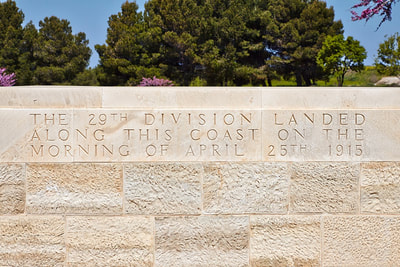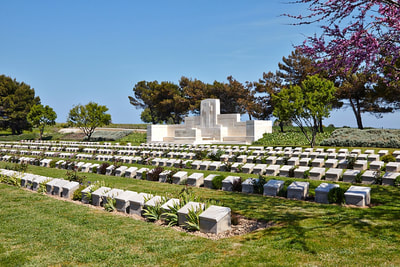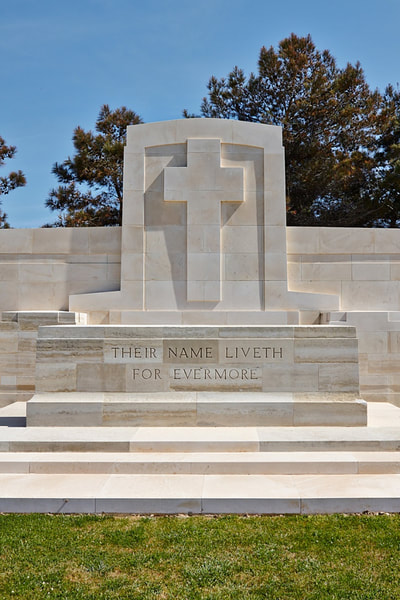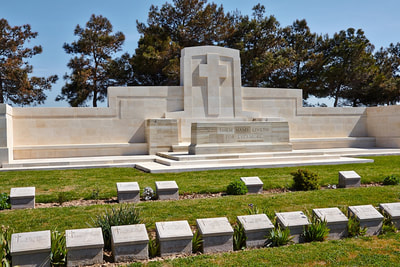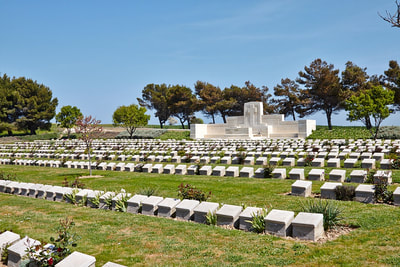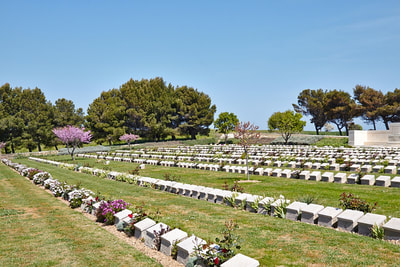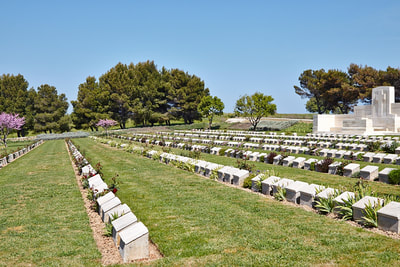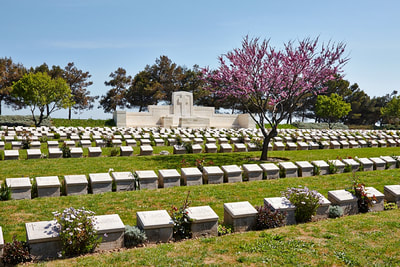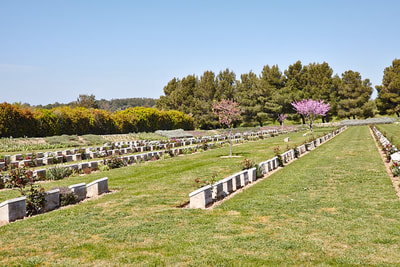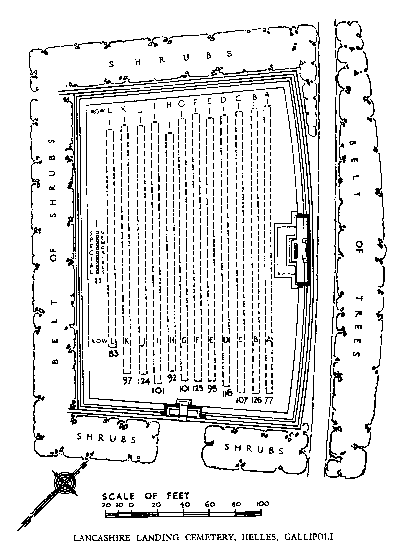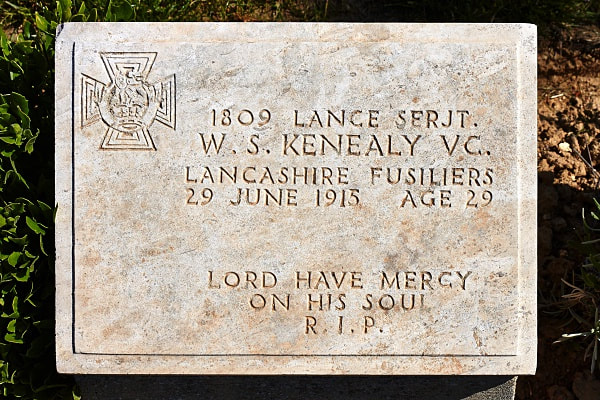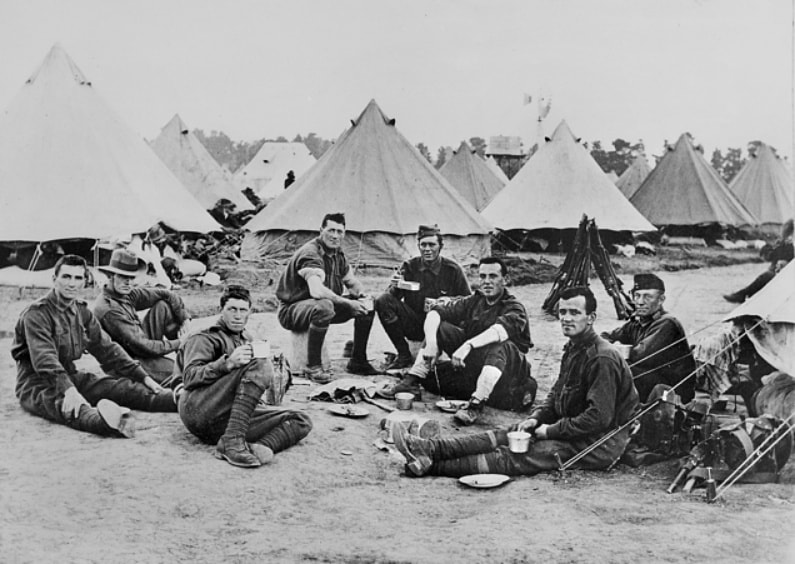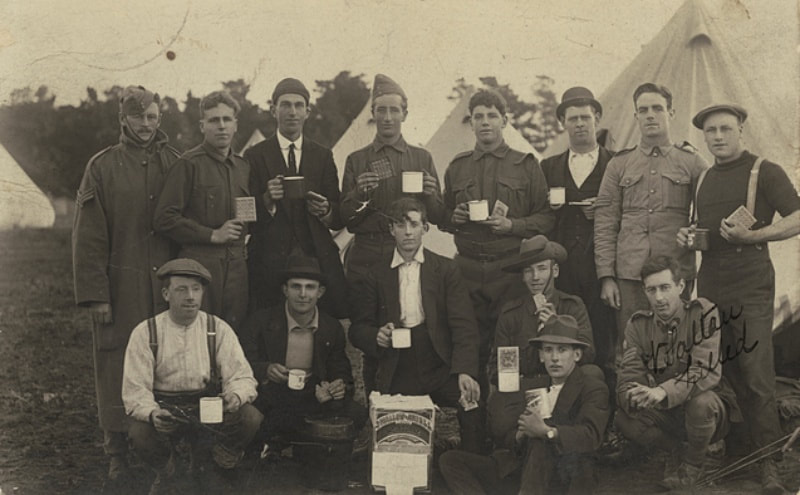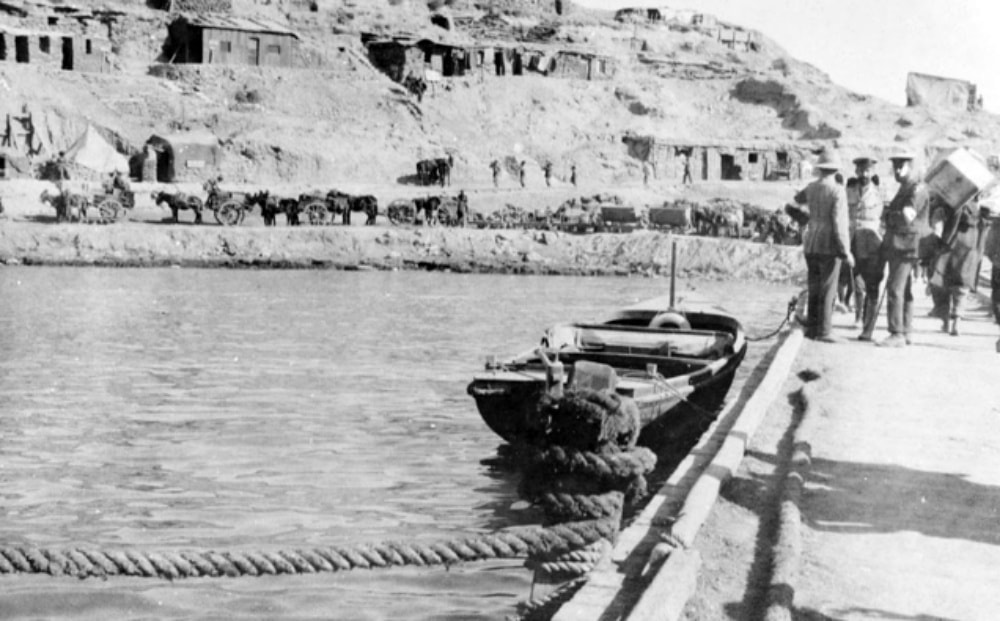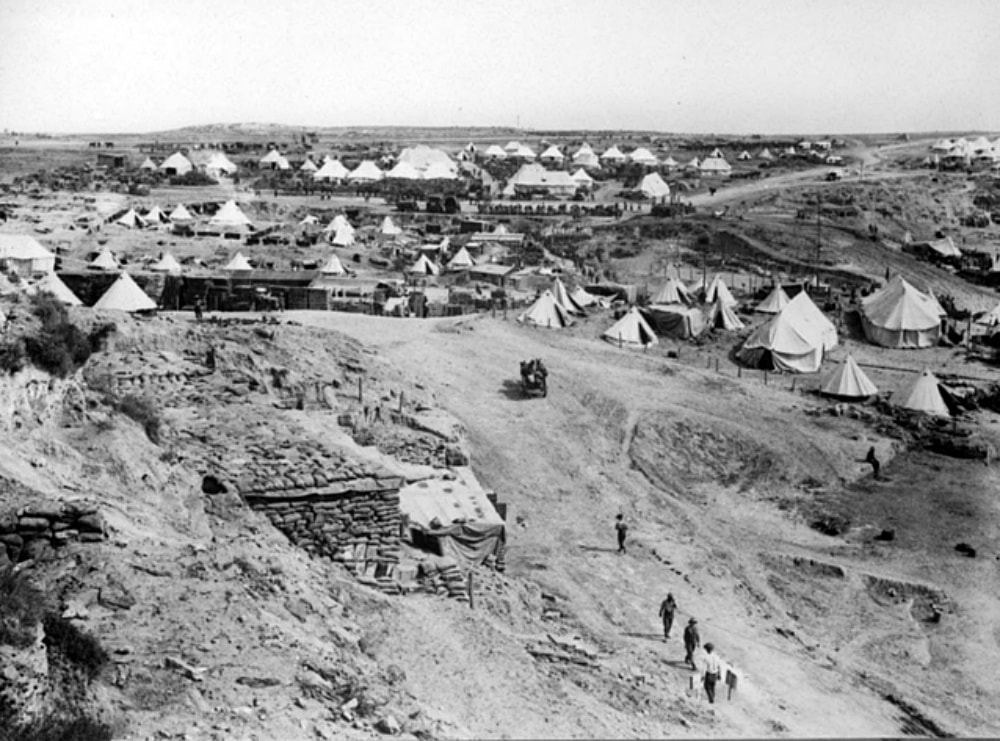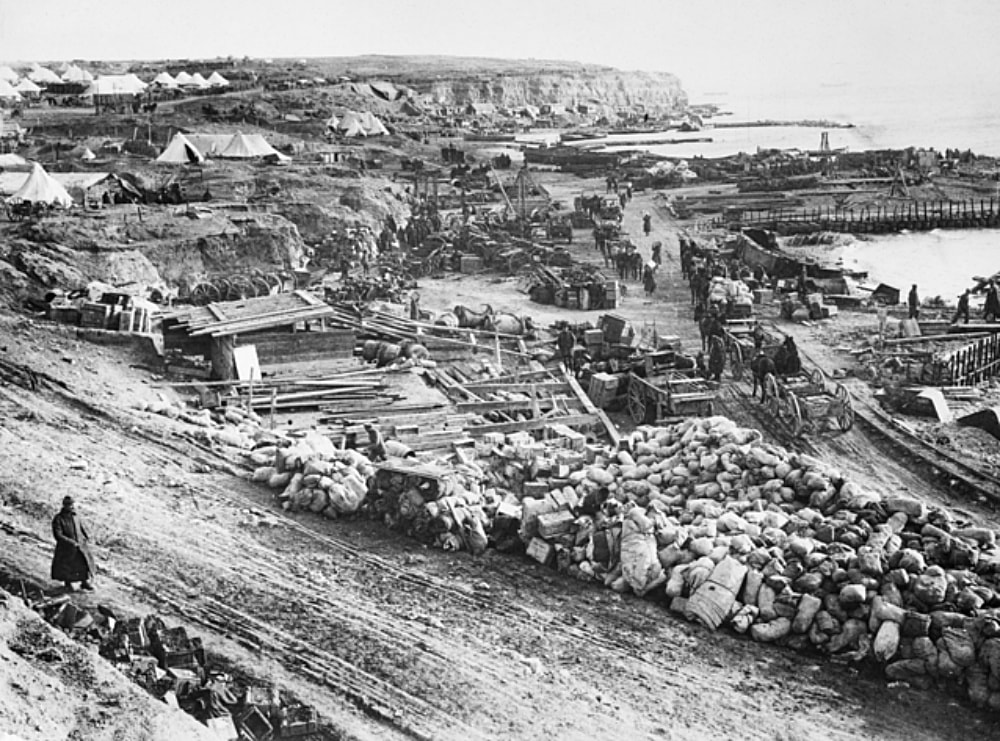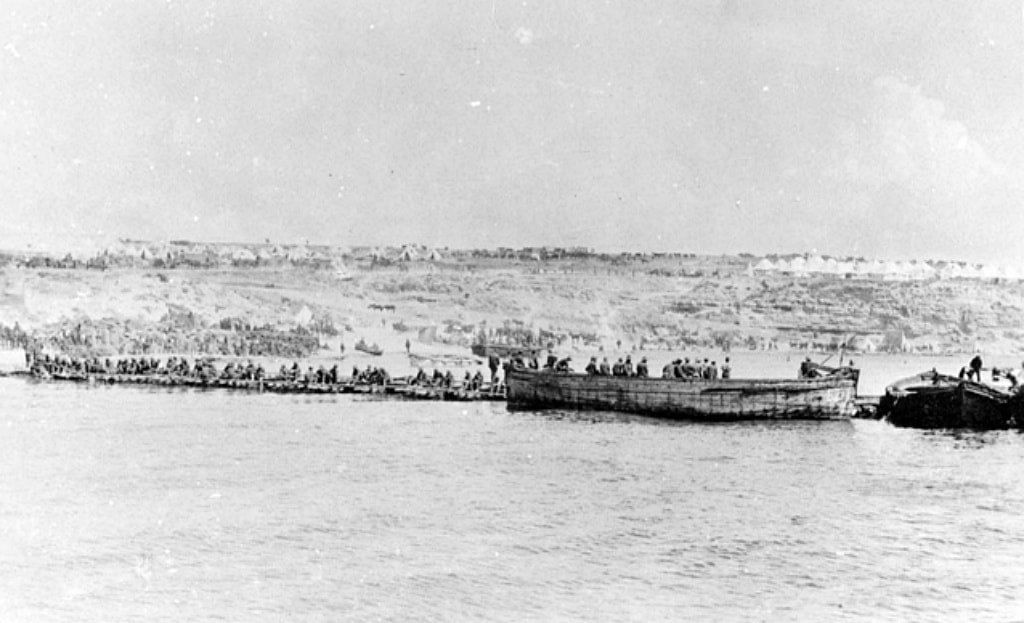LANCASHIRE LANDING CEMETERY
Gallipoli
Turkey
Location Information
Follow the road to Helles opposite the Kabatepe Museum. At 14.2kms take a right turn at the 'T' junction and at 14.3 kms. take the left fork. After a total of 21.6 kms. you will find Lancashire Landing cemetery on your right.
Visiting Information
The Cemetery is permanently open and may be visited at any time.
Historical Information
The eight month campaign in Gallipoli was fought by Commonwealth and French forces in an attempt to force Turkey out of the war, to relieve the deadlock of the Western Front in France and Belgium, and to open a supply route to Russia through the Dardanelles and the Black Sea.
The Allies landed on the peninsula on 25-26 April 1915; the 29th Division at Cape Helles in the south and the Australian and New Zealand Corps north of Gaba Tepe on the west coast, an area soon known as Anzac.
At Helles, the 29th Division landed troops at 'S,' 'V,' 'W,' 'X' and 'Y' Beaches, five small coves at or near the southern end of the peninsula. The landing at 'Y' Beach (Gurkha Bluffs) was carried out by the 1st King's Own Scottish Borderers and the Plymouth Battalion of the Royal Naval Division, but these troops were forced to re-embark on the following day. The 2nd Royal Fusiliers landed at 'X' Beach, followed by the rest of the 87th Brigade. Under very severe fire, the 1st Lancashire Fusiliers landed on 'W' Beach and cut their way through wire entanglements and trenches to the edge of the cliff. They and the other battalions of the 88th Brigade established themselves on the hills of Tekke Burnu and Helles Burnu. The beach became known as Lancashire Landing.
The greater part of the cemetery (Rows A to J and part of Row L) was made between the landing in April 1915 and the evacuation of the peninsula in January 1916. Row I contains the graves of over 80 men of the 1st Lancashire Fusiliers who died in the first two days following the landing. The 97 graves in Row K and graves 31 to 83 in Row L were brought in after the Armistice from the following Aegean islands cemeteries:-
KEPHALOS BRITISH CEMETERY, on the island of Imbros (Imbroz), was 640 metres inland from Kephalos Pier. There were buried in it 84 British, Australian and New Zealand sailors and soldiers, three Greeks, and one German prisoner.
KUSU BAY CEMETERY, on the island of Imbros (Imbroz), contained the graves of 45 officers and men (14 of them unidentified) of the monitors Raglan and M28, which were sunk by the German battle cruiser Goeben and cruiser Breslau as they attempted to break out into the Mediterranean from the Black Sea on 20 January 1918 (both the Breslau and the Goeben later struck mines, off Cape Kephalos, which resulted in the Breslau sinking and the Goeben being grounded of Chanak).
PANAGHIA CHURCHYARD, on the island of Imbros (Imbroz), contained the graves of one officer and five men from the monitors and four airmen of the 62nd Wing, Royal Air Force.
PARASKEVI CEMETERY, near the South-West shore of the island of Tenedos (Bozcaada), contained the graves of four sailors, one soldier and one marine.
There are now 1,237 Commonwealth servicemen of the First World War buried or commemorated in this cemetery. 135 of the burials are unidentified but special memorials commemorate ten casualties who are known to be buried among them. The cemetery also contains 17 Greek war graves.
Identified Casualties
United Kingdom 1072
Australia 26,
New Zealand 4
India 3
Canada 2
Cemetery pictures © Geerhard Joos
Follow the road to Helles opposite the Kabatepe Museum. At 14.2kms take a right turn at the 'T' junction and at 14.3 kms. take the left fork. After a total of 21.6 kms. you will find Lancashire Landing cemetery on your right.
Visiting Information
The Cemetery is permanently open and may be visited at any time.
Historical Information
The eight month campaign in Gallipoli was fought by Commonwealth and French forces in an attempt to force Turkey out of the war, to relieve the deadlock of the Western Front in France and Belgium, and to open a supply route to Russia through the Dardanelles and the Black Sea.
The Allies landed on the peninsula on 25-26 April 1915; the 29th Division at Cape Helles in the south and the Australian and New Zealand Corps north of Gaba Tepe on the west coast, an area soon known as Anzac.
At Helles, the 29th Division landed troops at 'S,' 'V,' 'W,' 'X' and 'Y' Beaches, five small coves at or near the southern end of the peninsula. The landing at 'Y' Beach (Gurkha Bluffs) was carried out by the 1st King's Own Scottish Borderers and the Plymouth Battalion of the Royal Naval Division, but these troops were forced to re-embark on the following day. The 2nd Royal Fusiliers landed at 'X' Beach, followed by the rest of the 87th Brigade. Under very severe fire, the 1st Lancashire Fusiliers landed on 'W' Beach and cut their way through wire entanglements and trenches to the edge of the cliff. They and the other battalions of the 88th Brigade established themselves on the hills of Tekke Burnu and Helles Burnu. The beach became known as Lancashire Landing.
The greater part of the cemetery (Rows A to J and part of Row L) was made between the landing in April 1915 and the evacuation of the peninsula in January 1916. Row I contains the graves of over 80 men of the 1st Lancashire Fusiliers who died in the first two days following the landing. The 97 graves in Row K and graves 31 to 83 in Row L were brought in after the Armistice from the following Aegean islands cemeteries:-
KEPHALOS BRITISH CEMETERY, on the island of Imbros (Imbroz), was 640 metres inland from Kephalos Pier. There were buried in it 84 British, Australian and New Zealand sailors and soldiers, three Greeks, and one German prisoner.
KUSU BAY CEMETERY, on the island of Imbros (Imbroz), contained the graves of 45 officers and men (14 of them unidentified) of the monitors Raglan and M28, which were sunk by the German battle cruiser Goeben and cruiser Breslau as they attempted to break out into the Mediterranean from the Black Sea on 20 January 1918 (both the Breslau and the Goeben later struck mines, off Cape Kephalos, which resulted in the Breslau sinking and the Goeben being grounded of Chanak).
PANAGHIA CHURCHYARD, on the island of Imbros (Imbroz), contained the graves of one officer and five men from the monitors and four airmen of the 62nd Wing, Royal Air Force.
PARASKEVI CEMETERY, near the South-West shore of the island of Tenedos (Bozcaada), contained the graves of four sailors, one soldier and one marine.
There are now 1,237 Commonwealth servicemen of the First World War buried or commemorated in this cemetery. 135 of the burials are unidentified but special memorials commemorate ten casualties who are known to be buried among them. The cemetery also contains 17 Greek war graves.
Identified Casualties
United Kingdom 1072
Australia 26,
New Zealand 4
India 3
Canada 2
Cemetery pictures © Geerhard Joos

1809 Lance Serjeant William Stephen Kenealy, V. C.
1st Bn. Lancashire Fusiliers, 29th June 1915, aged 29. Won the award 25th April 1915. Row C. 104.
Son of John and Margaret Kenealy, of 361, Bolton Rd., Stubshaw Cross, Ashton-in-Makerfield, Lancs.
Citation: An extract from "The London Gazette" (No. 29273) dated 24th Aug., 1915, records the following:- "On 25th April, 1915, three companies, and the Headquarters of the 1st Bn. Lancashire Fusiliers, in effecting a landing on the Gallipoli Peninsula to the West of Cape Helles, were met by a very deadly fire from hidden machine guns which caused a great number of casualties. The survivors, however, rushed up to and cut the wire entanglements, notwithstanding the terrific fire from the enemy, and after overcoming supreme difficulties, the cliffs were gained and the position maintained. Amongst the many very gallant officers and men engaged in this most hazardous undertaking, Capt. Willis, Serjt. Richards, and Pte. Kenealy have been selected by their comrades as having performed the most signal acts of bravery and devotion to duty.
1st Bn. Lancashire Fusiliers, 29th June 1915, aged 29. Won the award 25th April 1915. Row C. 104.
Son of John and Margaret Kenealy, of 361, Bolton Rd., Stubshaw Cross, Ashton-in-Makerfield, Lancs.
Citation: An extract from "The London Gazette" (No. 29273) dated 24th Aug., 1915, records the following:- "On 25th April, 1915, three companies, and the Headquarters of the 1st Bn. Lancashire Fusiliers, in effecting a landing on the Gallipoli Peninsula to the West of Cape Helles, were met by a very deadly fire from hidden machine guns which caused a great number of casualties. The survivors, however, rushed up to and cut the wire entanglements, notwithstanding the terrific fire from the enemy, and after overcoming supreme difficulties, the cliffs were gained and the position maintained. Amongst the many very gallant officers and men engaged in this most hazardous undertaking, Capt. Willis, Serjt. Richards, and Pte. Kenealy have been selected by their comrades as having performed the most signal acts of bravery and devotion to duty.
Eight soldiers of C Company, 7th Battalion, share a relaxed meal amongst the tents at Broadmeadows camp. Identified from left to right: 382 Corporal Rupert Acaster Lee (wounded 8 May at Gallipoli and invalided home to Australia on 15 August 1915); 379 Private (Pte) George Walker (wounded 7-11 May at Gallipoli, invalided to Australia on 29 July 1915); 377 Pte James Munro (killed in action on 25 April 1915, buried at No 2 Outpost Cemetery, Galllipoli); Lieutenant Walter Edward Lane (returned to Australia 24 January 1919); 347 Pte Strutten John Carter (killed in action on 25 April 1915, buried No 2 Outpost Cemetery, Gallipoli); 372 Lance Corporal Horatio Harold Roberts Baker (died of wounds on 10 May 1915, buried at Lancashire Landing Cemetery, Gallipoli); 383 Sergeant Egbert Harrison Acaster Lee (returned to Australia 17 October 1916 following extended illness); and J Corrigan (probably 388 Pte James Corrigan, killed in action 13 November 1917 and buried at The Huts Cemetery, Belgium). These men later formed B Company when C and D Companies were amalgamated in January 1915.
372 Lance Corporal Horatio Harold Robert Baker, 7th Bn. Australian Infantry, A. I. F. Died 19th May 1915, aged 28. Son of Joseph and Susannah Baker, of Hay, Hereford, England. Row E. 43.
372 Lance Corporal Horatio Harold Robert Baker, 7th Bn. Australian Infantry, A. I. F. Died 19th May 1915, aged 28. Son of Joseph and Susannah Baker, of Hay, Hereford, England. Row E. 43.
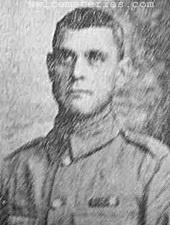
2283Private
Herbert Bray
1/5th East Lancashire Regiment
Died of Wounds 26th June 1915,
aged 44.
Plot C. 80.
Father of Allan Bray, of 74, Milton St., Burnley.
Herbert Bray
1/5th East Lancashire Regiment
Died of Wounds 26th June 1915,
aged 44.
Plot C. 80.
Father of Allan Bray, of 74, Milton St., Burnley.
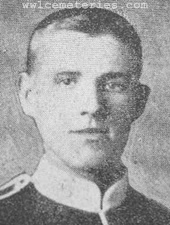
9832 Private
Herbert Brogden
1st Border Regiment
Died of Wounds 29th June 1915.
Plot F. 20.
Lived at 46 Hurtley Street, Burnley, Lancashire.
Herbert Brogden
1st Border Regiment
Died of Wounds 29th June 1915.
Plot F. 20.
Lived at 46 Hurtley Street, Burnley, Lancashire.
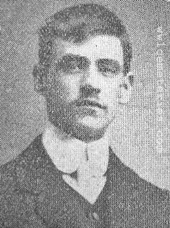
2284 Private
Joseph Cocker
1/5th East Lancashire Regiment
Killed in Action 19th May 1915, aged 31.
Plot C. 21.
Son of Thomas and Maria Cocker, of 17, King's Terrace, Burnley, Lancs.
Joseph Cocker
1/5th East Lancashire Regiment
Killed in Action 19th May 1915, aged 31.
Plot C. 21.
Son of Thomas and Maria Cocker, of 17, King's Terrace, Burnley, Lancs.
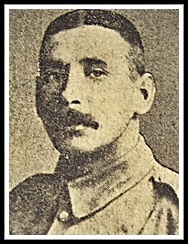
1956 Private
Albert Graham
1/5th Manchester Regiment
Died of Wounds 10th July 1915, aged 30.
Plot D. 93.
Son of Robert and Emma Graham, of 37, Thursby Rd., Burnley. Native of Monaghan.
Albert Graham
1/5th Manchester Regiment
Died of Wounds 10th July 1915, aged 30.
Plot D. 93.
Son of Robert and Emma Graham, of 37, Thursby Rd., Burnley. Native of Monaghan.
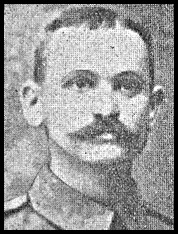
2308 Lance Corporal
Walter Greenwood
1/5th East Lancashire Regiment
Died of Wounds 23rd May 1915, aged 42.
Plot C. 12.
Lived at 2 Pritchard Street, Burnley, Lancashire.
Husband of Jessie Greenwood, of 169, Shawmet Avenue, New Bedford, Mass, U.S.A.
Walter Greenwood
1/5th East Lancashire Regiment
Died of Wounds 23rd May 1915, aged 42.
Plot C. 12.
Lived at 2 Pritchard Street, Burnley, Lancashire.
Husband of Jessie Greenwood, of 169, Shawmet Avenue, New Bedford, Mass, U.S.A.
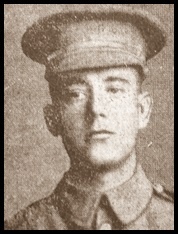
2123 Private
Walter Hall
1/5th East Lancashire Regiment
Died of Wounds 6th July 1915.
Plot D. 86.
Enlisted in Burnley
Walter Hall
1/5th East Lancashire Regiment
Died of Wounds 6th July 1915.
Plot D. 86.
Enlisted in Burnley
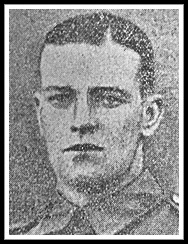
2082 Private
Albert Hepworth
1/5th East Lancashire Regiment
Died of Wounds 13th June 1915, aged 23.
Plot B. 99.
Lived at 8 Rumley Road, Burnley, Lancashire.
Albert Hepworth
1/5th East Lancashire Regiment
Died of Wounds 13th June 1915, aged 23.
Plot B. 99.
Lived at 8 Rumley Road, Burnley, Lancashire.

1741 Private
George Holt
1/5th East Lancashire Regiment
Died of Wounds 11th June 1915, aged 22.
Plot B. 91.
Son of Edward and Ellen Holt, of 7, Milner St., Burnley.
George Holt
1/5th East Lancashire Regiment
Died of Wounds 11th June 1915, aged 22.
Plot B. 91.
Son of Edward and Ellen Holt, of 7, Milner St., Burnley.
Outdoor group portrait of new recruits at Seymour camp. Many of the men are holding mugs and their Swallow and Ariell hardtack biscuits. The open biscuit box is on the ground in front of them. Identified are 390 Sergeant (Sgt) Robert Maxwell Finch (back row, second from right) and 393 Colour Sergeant Victor Leslie Saltau (front row far right). Both men are members of E Company, 5th Battalion and embarked from Melbourne on HMAT Orvieto on 21 October 1914. Sgt Finch, an electrician from Mordialloc, Victoria prior to enlistment, was wounded in action during the Gallipoli landing. Later promoted to Company Sergeant Major, he returned to Australia on 13 December 1914 suffering from enteric fever and was medically discharged. Following his recovery, he re-enlisted with the rank of Private and the service number 59013, although due to his medical condition, he was classified as fit for home service. Colour Sergeant Saltau was later promoted to Second Lieutenant and while serving at Gallipoli, was wounded in action. On 10 May 1915, aged 27, he succumbed to his wounds and was buried in the Lancashire Landing Cemetery, Gallipoli. His brother 115 Lance Corporal Brian John Saltau was killed in action in France and is
Second Lieutenant Victor Leslie Saltau, 5th Bn. Australian Infantry, A. I. F. died 10th May 1915, aged 27. Row E. 34. Son of John and Isabella Saltau; husband of L. C. Saltau, of 40, Newman St., West Brunswick, Victoria, Australia.
Inscription "The beloved husband of Lydia C. Saltau and father of Cora and Vera".
Second Lieutenant Victor Leslie Saltau, 5th Bn. Australian Infantry, A. I. F. died 10th May 1915, aged 27. Row E. 34. Son of John and Isabella Saltau; husband of L. C. Saltau, of 40, Newman St., West Brunswick, Victoria, Australia.
Inscription "The beloved husband of Lydia C. Saltau and father of Cora and Vera".

42156 Driver
Joseph Wakelam
26th Bty. Royal Field Artillery
7th June 1915.
Row B. 64.
Eldest son of Isaac Henry Wakelam and Martha Wakelam of Birkenhead, Cheshire
Pictures courtesy of niece, June Byrne


